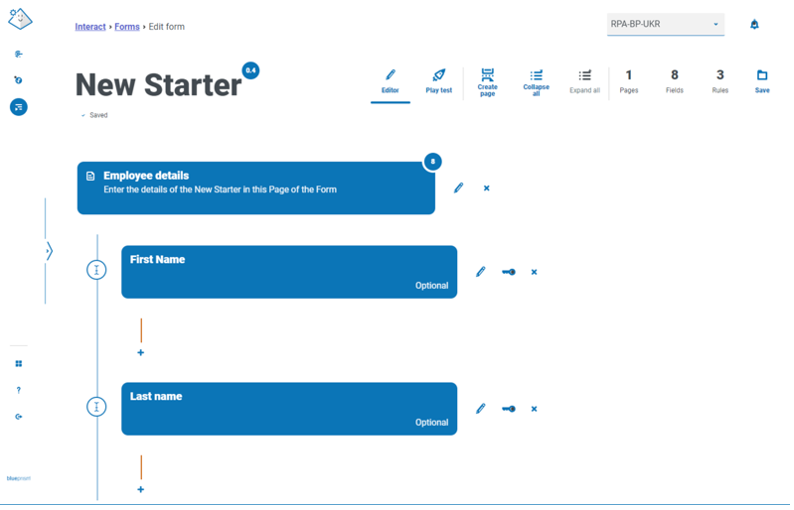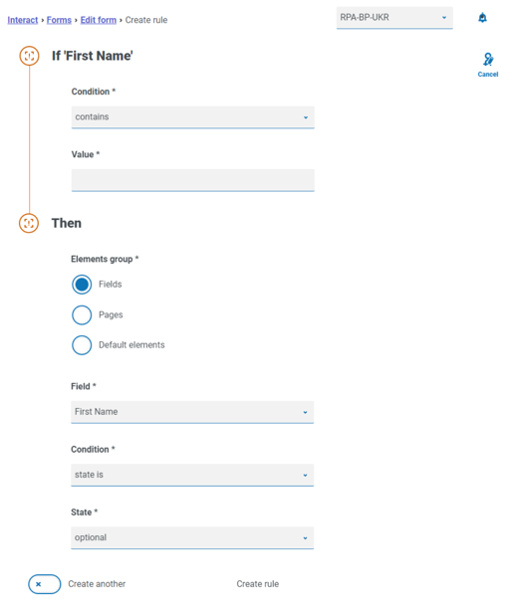Blog
How To Automate a Manual Process
Contact Us
Form filling seems simple enough. You can add your name, email, job title and inquiry. In the back end, you can access this information about the contact. But forms have so much more potential, and their corresponding tools are more powerful than you might realize.
When we make this form smart, we’re automating it and connecting it with all our systems; it becomes the show’s star. It doesn't just save time by getting rid of manual work, but it also makes information flow smoothly through our organization, making everything work better together. Sure, you can collect standard information such as names and phone numbers with a basic form, but when you bring in form automation, it opens up a whole new world.
Now, you can also automate responses and follow-ups, personalize interactions and enhance user experience. It’s no longer about just collecting details; it’s about elevating your data collection to where you can utilize every piece of information in a way that suits your goals and objectives.
So, don't underestimate the power of a well-organized and automated form. Stay tuned as we’re here to tell you all its secrets.
Form automation is simply the use of automation software and tools to streamline form and survey workflows. When set up, it allows organizations to create, manage and process all forms digitally and automatically.
For example, you can create filter questions on a sales inquiry form that helps you categorize and score your leads. You can then create appropriate follow-ups and automatically enroll people who fill out the form.
A simple form automation workflow might look like this: New contact fills in the form > contact's information is seamlessly integrated into the customer relationship management (CRM) system > new contact gets sent an automatic thank you email and confirmation of all their information > system assigns an employee to take over based on criteria > employee gets sent an internal notification with relevant details to follow up.
This basic automation not only ensures your new contact gets confirmation of their submission, but also ensures accountability and follow-ups are carried out by relevant workers. Each step of the workflow is seamlessly executed, saving time, minimizing manual interventions and enhancing the overall experience for both the contact and the employee. This also leaves employees free from repetitive tasks, such as data entry into the CRM or responding to each email, to focus on higher-value activities.
Here are some common forms you automate besides the basic “contact us”:
Automating forms can bring several benefits to your organization. Here are a few of the key ones below.
Automated forms can personalize any future communications with leads or contacts. Forms capture specific details during the form-filling process, such as a first name or product interests, which organizations can then automatically use to tailor recommendations, communications or sales proposals. Personalization can help enhance engagement, build trust and make interactions more meaningful, whether it's sending follow-ups or marketing messages.
For example, the form might capture what services your lead is interested in. Your workflow can then automatically send relevant content, such as a sales brochure about that service, to them within minutes.
Form automation reduces the manual effort involved with regular forms and ensures that form workflows are faster and more efficient. Employees no longer need to manually enter data captured from forms into their internal systems, which can also leave space for error. Employees also no longer need to manually confirm each form entry. Instead, automated systems do it within seconds.
Speeding up work also means that contacts who filled in the forms can expect faster response times. Whether it’s automated responses or routing for an employee to reply, form automation means quicker reactions to form submissions to improve customer experience or internal stakeholder satisfaction.
As information is captured directly from the contact and entered into systems as it comes, the data captured is more accurate than an employee noting it down from the phone or reading a customer’s handwriting. This lowers the risk of human error.
Additionally, automation can ensure the information collected is categorized appropriately and only available to be viewed or used by the right employees. Automation also helps enforce compliance by ensuring the data collection process adheres to relevant data protection regulations.
Automated workflows ensure that form filling and any follow-up processes are always consistent. They standardize the process, reducing any variability and promoting good data practices. For example, names are captured and entered into databases in a consistent format or contacts can select country codes from a list instead of typing them out to remove variations. This will also help with reporting down the line, as all data is standardized.
Here's a case to illustrate these benefits in action. One of SS&C Blue Prism’s healthcare clients was able to give 45 days back to employees every year and improve data quality through the help of automations, including forms. They used forms to log patient records on their systems and manage referrals from there. In the end, it gave back significant time so employees could better focus on patient care rather than administrative work.
As part of workflow automation software, forms automation software is designed to make the process of creating, designing, implementing and managing digital forms as simple and streamlined as possible. Here are a few of the best features that you can find in form automation software:
Key Feature | Explanation |
Form builder | Most form builders will have an intuitive and easy drag-and-drop interface so users can create forms without coding expertise. Many software programs will also let you customize the design of your form, such as changing color or adding images. |
Form templates | Maybe you don’t want to create a form from scratch. Many vendors provide pre-made templates for you to choose from, whether you are looking to create a simple contact us form or a more complex quotation form. |
Workflow automation and conditional logic | Here’s where you will be able to create your automations for form-related processes. This includes notifications, responses and follow-ups, eliminating manual interventions and enhancing efficiency. Rules can be used when specific conditions are met, depending on the form function. For example, if a contact fills out the contact us form, you can automatically send an email to thank them in five minutes. You can also then set a rule to say if an employee with a specific organizational email fills this form, they don’t enter the workflow. |
Integration capabilities | This is how you get your form online in the right place. And how you can set up how your form interacts with your other management tools and systems, such as a CRM platform or email marketing software to facilitate information flow across the organization. |
Security measures and user permissions | This feature will let you control who has access to view, edit and create the forms and their accompanying automations. |
Analytics and reporting | Many automation tools have built-in reporting and analytic options. You can track and analyze your form submissions to provide insights into your forms. For example, you can see the form fill rate or view rate. |
Form storage | Here is where you will be able to see all the forms you created in a centralized location for easy access. Some tools may also let you categorize them for quick and easier retrieval. |
Autofill capabilities | To make it even more user-friendly to fill in forms, you can set your forms to populate certain fields based on default values or previously entered information. |
If you still require forms to be paper-based, that’s no problem at all! Advanced automation technology can be used to connect the dots and bring this information to digital means. Using optical character recognition (OCR), you can convert handwritten forms into structured formats that are legible by machines. Robotic process automation (RPA) digital workers can then take this information and add it into an automated workflow and let the magic continue to happen, automatically.
So, we’ve gone into depth about what form automation is, its benefits and the software features, but how exactly can you automate your forms? We’ll be using SS&C | Blue Prism Interact, our collaborative attended automation platform with no-code form features, and SS&C | Blue Prism UX Builder, our no-code development software platform to build enterprise web applications, as an example.
Clearly outline the goals of your form and your form automation. For example, what do you want to achieve? Is it to implement better customer feedback systems or lead generation opportunities? You might want to identify specific processes and workflows you want to streamline to help inform your decision.
This will inform how you set up your form and its accompanying automation.
You’ll want to map out exactly how you want your form and automation to go. Clearly understand what information you want to add and collect, and how that data will be used. Before creating a form on Interact, you’re required to create a business process to define the process within your organization.
Here’s where you can create your form fields, including options like the name, job title, email, etc. Below is an example via Interact. Both Interact and UX Builder have easy no-code drag-and-drop functions for you to create forms on pages with additional options for images, tables and content.

If you’re going for a more complex form that requires logic, you can also create that through Interact and UX Builder. Simply fill out the logic you want to happen. Below is an example of a rule for the first name field.

You will then need to create your follow-up actions after the form is submitted; for example, will you be sending an automatic email and informing an internal employee, or are there any other processes present that need to happen? In UX Builder , you can create and build enterprise web applications and forms without needing a developer or knowing a single line of code.
Interact is great if you require human-in-the-loop solutions, such as human intervention or collaboration as the digital workforce encounters unknowns that require further input and validation or require authorization or human decision-making.
Before deploying your automated forms, thoroughly test them to ensure that all components, such as conditional logic, automation rules and integrations, are working as intended. In Interact, you can click “Play test” when viewing or editing a form to test the fields and functionality and view the form as it will look to an Interact user. It allows you to test and verify that any rules or field restrictions work as required.
Once you’ve checked that your forms and accompanying automations are working, you can go live and add it to where you need it to be!
Don’t forget to monitor your forms and automations as they live on. This allows you to track form performance, analyze user behavior and gather insights about your forms and automation to see where it can be improved. Below, you can see how Interact shows submission histories.

There’s no good reason why forms need to take up so many resources, time and manual effort. By embracing form automation, you not only alleviate the burdens associated with traditional form processes but also set the benchmark for a more streamlined, efficient and simpler approach to collecting and handling data within your organization.
Get in touch to learn more about Interact and UX Builder.
If your network blocks YouTube, you may not be able to view the video on this page. In this case, please use another device. Pressing play on the video will set third-party YouTube cookies. Please read our Cookies Policy for more information.